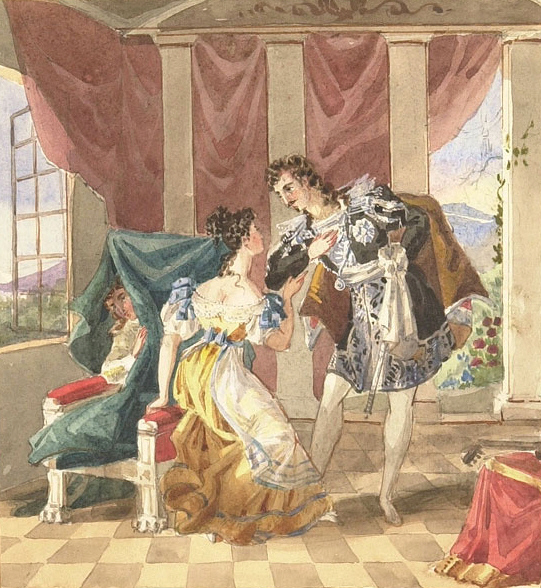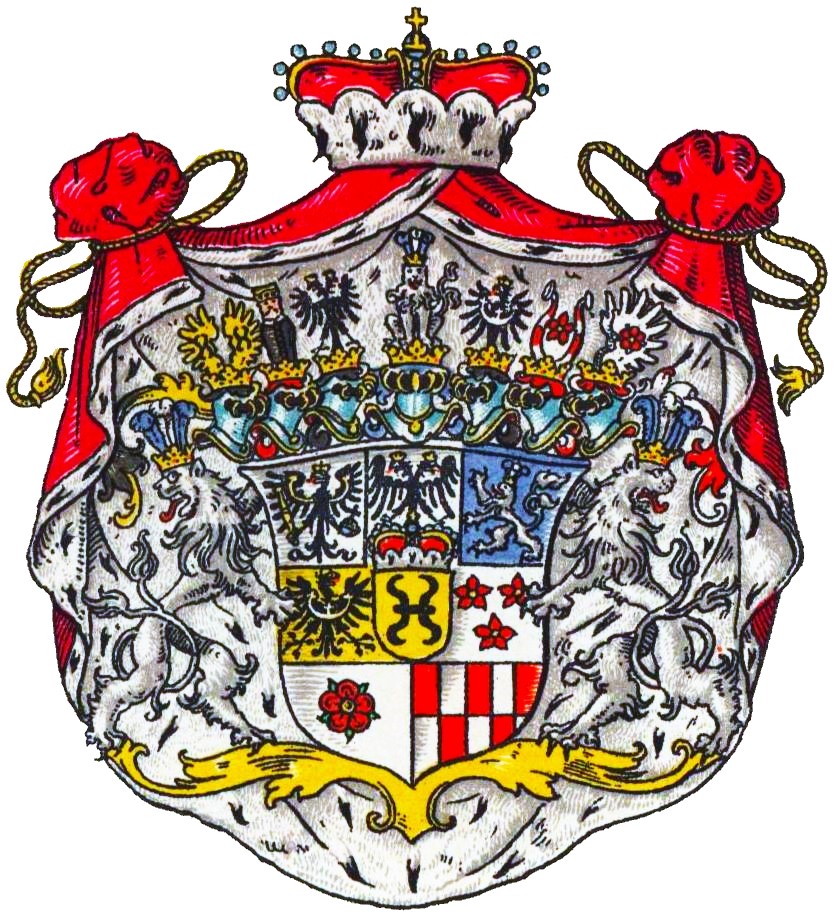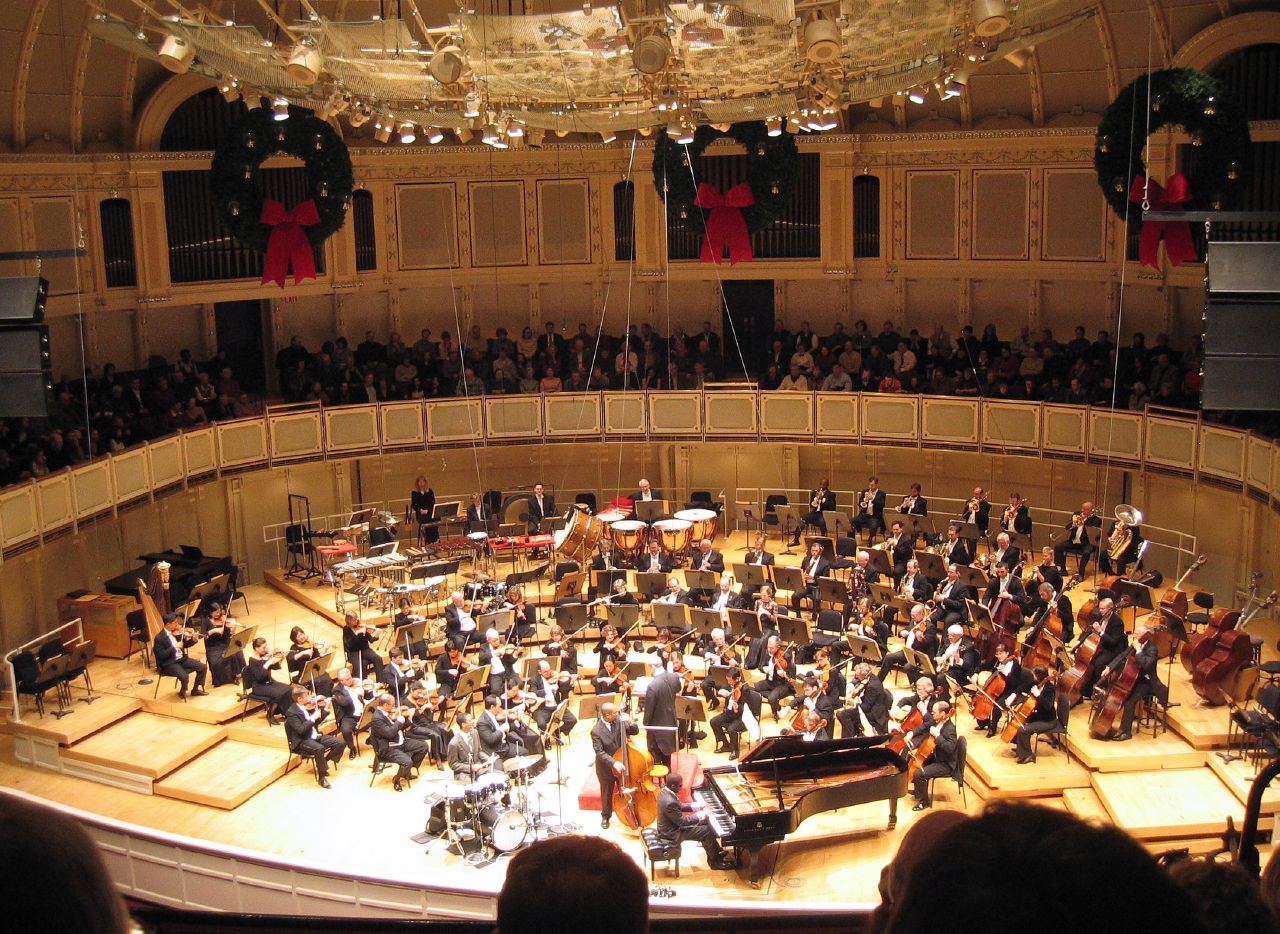|
Non Piu, Tutto Ascoltai
"Non più. Tutto ascoltai...Non temer, amato bene", K. 490, is a concert aria by Wolfgang Amadeus Mozart for solo tenor and orchestra, composed in Vienna in 1786. Originally written for the tenor voice, the aria is mostly now performed by sopranos. The text of this aria is taken from Mozart's 1781 opera ''Idomeneo'', by Giambattista Varesco. The aria was published by Breitkopf & Härtel in 1881. Description The recitative "Non più. Tutto ascoltai" (No more! I have heard all) begins in allegro tempo in the key of C major. The aria commences at bar 52, marked "Rondo – Andante" in B-flat major, introduced by the solo violin, which accompanies the singer to the finale at bar 172. Both are in common time and written in the treble clef. The orchestra consists of two clarinets, two bassoons, two natural horns, a solo violin and a string section. A typical performance takes around ten minutes. The characters are Ilia, princess of Troy and her beloved Idamante, prince of Crete. Ilia ... [...More Info...] [...Related Items...] OR: [Wikipedia] [Google] [Baidu] |
Mozart (unfinished) By Lange 1782
Wolfgang Amadeus Mozart (27 January 1756 – 5 December 1791) was a prolific and influential composer of the Classical period (music), Classical period. Despite his short life, his rapid pace of composition and proficiency from an early age resulted in List of compositions by Wolfgang Amadeus Mozart, more than 800 works representing virtually every Western classical genre of his time. Many of these compositions are acknowledged as pinnacles of the symphony, symphonic, concerto, concertante, chamber music, chamber, operatic, and choir, choral repertoires. Mozart is widely regarded as one of the greatest composers in the history of Classical music, Western music, with his music admired for its "melodic beauty, its formal elegance and its richness of harmony and texture". Born in Salzburg, Mozart showed Child prodigy, prodigious ability from his earliest childhood. At age five, he was already competent on keyboard and violin, had begun to compose, and performed before European r ... [...More Info...] [...Related Items...] OR: [Wikipedia] [Google] [Baidu] |
Common Time
A time signature (also known as meter signature, metre signature, and measure signature) is an indication in music notation that specifies how many note values of a particular type fit into each measure ( bar). The time signature indicates the meter of a musical movement at the bar level. In a music score the time signature appears as two stacked numerals, such as (spoken as ''four–four time''), or a time symbol, such as (spoken as ''common time''). It immediately follows the key signature (or if there is no key signature, the clef symbol). A mid-score time signature, usually immediately following a barline, indicates a change of meter. Most time signatures are either simple (the note values are grouped in pairs, like , , and ), or compound (grouped in threes, like , , and ). Less common signatures indicate complex, mixed, additive, and irrational meters. Time signature notation Most time signatures consist of two numerals, one stacked above the other: * The '' ... [...More Info...] [...Related Items...] OR: [Wikipedia] [Google] [Baidu] |
Stanley Sadie
Stanley John Sadie (; 30 October 1930 – 21 March 2005) was a British musicologist, music critic, and editor. He was editor of the sixth edition of the '' Grove Dictionary of Music and Musicians'' (1980), which was published as the first edition of ''The New Grove Dictionary of Music and Musicians''. Along with Thurston Dart, Nigel Fortune and Oliver Neighbour he was one of Britain's leading musicologists of the post-World War II generation. Career Born in Wembley, Sadie was educated at St Paul's School, London, and studied music privately for three years with Bernard Stevens. At Gonville and Caius College, Cambridge he read music under Thurston Dart. Sadie earned Bachelor of Arts and Bachelor of Music degrees in 1953, a Master of Arts degree in 1957, and a PhD in 1958. His doctoral dissertation was on mid-eighteenth-century British chamber music. After Cambridge, he taught at Trinity College of Music, London (1957–1965). Sadie then turned to music journalism, beco ... [...More Info...] [...Related Items...] OR: [Wikipedia] [Google] [Baidu] |
The Marriage Of Figaro
''The Marriage of Figaro'' (, ), K. 492, is a ''commedia per musica'' (opera buffa) in four acts composed in 1786 by Wolfgang Amadeus Mozart, with an Italian libretto written by Lorenzo Da Ponte. It premiered at the Burgtheater in Vienna on 1 May 1786. The opera's libretto is based on the 1784 stage comedy by Pierre Beaumarchais, '' La folle journée, ou le Mariage de Figaro'' ("The Mad Day, or The Marriage of Figaro"). It tells how the servants Figaro and Susanna succeed in getting married, foiling the efforts of their philandering employer Count Almaviva to seduce Susanna and teaching him a lesson in fidelity. Considered one of the greatest operas ever written, it is a cornerstone of the repertoire and appears consistently among the top ten in the Operabase list of most frequently performed operas. In 2017, BBC News Magazine asked 172 opera singers to vote for the best operas ever written. ''The Marriage of Figaro'' came in first out of the 20 operas featured, with t ... [...More Info...] [...Related Items...] OR: [Wikipedia] [Google] [Baidu] |
House Of Hatzfeld
The House of Hatzfeld, also spelled House of Hatzfeldt, is the name of an ancient and influential German nobility, German noble family, whose members played important roles in the history of the Holy Roman Empire, Kingdom of Prussia, Prussia and Austro-Hungarian Empire, Austria. History They belonged to high nobility originally from Hesse. The family is first mentioned in 1138 and has its ancestral seat in Hatzfeld. In 1418 the family inherited Wildenburg Castle near Friesenhagen, a Lordship with Imperial immediacy, from the Lords of Wildenburg. Titles Melchior von Hatzfeld (1593–1658), Imperial field marshal in the Thirty Years' War, became the first Count in 1635. He was enfeoffed with Żmigród, Trachenberg Castle in Silesia in 1641, and Gleichen Castle with the town of Wandersleben in Thuringia in 1651. Franz Phillip Adrian became the first Prussian Fürst (''Prince of Hatzfeld-Gleichen-Trachenberg'') in 1741 (the branch extinguished in 1794). The ''Hatzfeldt-Werther-Sch ... [...More Info...] [...Related Items...] OR: [Wikipedia] [Google] [Baidu] |
Palais Auersperg
Palais Auersperg, for a short time called Palais Rosenkavalier, is a Baroque palace at Auerspergstraße 1 in the Josefstadt or eighth district of Vienna, Austria. History Palais Auersperg was built between 1706 and 1710 on the plot of the former ''Rottenhof'' according to the plans of two well-known architects, Johann Bernhard Fischer von Erlach and Johann Lukas von Hildebrandt, for Hieronymus Capece de Rofrano, to whom the former name ''Rosenkavalier'' refers. The middle section of the palace was altered between 1720 and 1723 by Johann Christian Neupauer.In 1749, Prince Joseph of Saxe-Hildburghausen started to use the palace as his winter residence. He hired Giuseppe Bonno as musical conductor of the palace. Between 1754 and 1761, weekly music courses were held during the winter months. From 1759, he rented the palace and hired Christoph Willibald Gluck as head conductor of the concerts held there.In 1777, Prince Johann Adam of Auersperg, friend and confidant of Emperor Francis ... [...More Info...] [...Related Items...] OR: [Wikipedia] [Google] [Baidu] |
Electra
Electra, also spelt Elektra (; ; ), is one of the most popular Greek mythology, mythological characters in tragedies.Evans (1970), p. 79 She is the main character in two Greek tragedies, ''Electra (Sophocles play), Electra'' by Sophocles and ''Electra (Euripides play), Electra'' by Euripides. She is also the central figure in plays by Aeschylus, Vittorio Alfieri, Alfieri, Voltaire, Hugo von Hofmannsthal, Hofmannsthal, Eugene O'Neill, and Jean-Paul Sartre. She is a vengeful soul in ''Oresteia#The Libation Bearers, The Libation Bearers'', the second play of Aeschylus' ''Oresteia'' trilogy. She plans out an attack with her brother to kill their mother, Clytemnestra. In psychology, the Electra complex is named after her. Family Electra's parents were King Agamemnon and Queen Clytemnestra of Mycenae. Her sisters were Iphigenia and Chrysothemis, and her brother was Orestes (mythology), Orestes. In the ''Iliad'', Homer is understood to be referring to Electra in mentioning "Laodice" as ... [...More Info...] [...Related Items...] OR: [Wikipedia] [Google] [Baidu] |
Crete
Crete ( ; , Modern Greek, Modern: , Ancient Greek, Ancient: ) is the largest and most populous of the Greek islands, the List of islands by area, 88th largest island in the world and the List of islands in the Mediterranean#By area, fifth largest island in the Mediterranean Sea, after Sicily, Sardinia, Cyprus, and Corsica. Crete is located about south of the Peloponnese, and about southwest of Anatolia. Crete has an area of and a coastline of 1,046 km (650 mi). It bounds the southern border of the Aegean Sea, with the Sea of Crete (or North Cretan Sea) to the north and the Libyan Sea (or South Cretan Sea) to the south. Crete covers 260 km from west to east but is narrow from north to south, spanning three longitudes but only half a latitude. Crete and a number of islands and islets that surround it constitute the Region of Crete (), which is the southernmost of the 13 Modern regions of Greece, top-level administrative units of Greece, and the fifth most popu ... [...More Info...] [...Related Items...] OR: [Wikipedia] [Google] [Baidu] |
Troy
Troy (/; ; ) or Ilion (; ) was an ancient city located in present-day Hisarlik, Turkey. It is best known as the setting for the Greek mythology, Greek myth of the Trojan War. The archaeological site is open to the public as a tourist destination, and was added to the List of World Heritage Sites in Turkey, UNESCO World Heritage list in 1998. Troy was repeatedly destroyed and rebuilt during its 4000 years of occupation. As a result, the site is divided into nine Stratigraphy (archaeology), archaeological layers, each corresponding to a city built on the ruins of the previous. Archaeologists refer to these layers using Roman numerals, Troy I being the earliest and Troy IX being the latest. Troy was first settled around 3600 BC and grew into a small fortified city around 3000 BC (Troy I). Among the early layers, Troy II is notable for its wealth and imposing architecture. During the Late Bronze Age, Troy was called Wilusa and was a vassal of the Hittite Empire. The final layer ... [...More Info...] [...Related Items...] OR: [Wikipedia] [Google] [Baidu] |
String Section
The string section of an orchestra is composed of bowed instruments belonging to the violin family. It normally consists of first and second violins, violas, cellos, and double basses. It is the most numerous group in the standard orchestra. In discussions of the Orchestration, instrumentation of a musical work, the phrase "the strings" or "and strings" is used to indicate a string section as just defined. An orchestra consisting solely of a string section is called a string orchestra. Smaller string sections are sometimes used in jazz, pop, and rock music and in the pit orchestras of musical theatre. Seating arrangement The most common seating arrangement in the 2000s is with first violins, second violins, violas, and cello sections arrayed clockwise around the Conductor (music), conductor, with basses behind the cellos on the right. The first violins are led by the concertmaster (leader in the UK); each of the other string sections also has a principal player (principal secon ... [...More Info...] [...Related Items...] OR: [Wikipedia] [Google] [Baidu] |
Violin
The violin, sometimes referred to as a fiddle, is a wooden chordophone, and is the smallest, and thus highest-pitched instrument (soprano) in regular use in the violin family. Smaller violin-type instruments exist, including the violino piccolo and the pochette (musical instrument), pochette, but these are virtually unused. Most violins have a hollow wooden body, and commonly have four strings (music), strings (sometimes five-string violin, five), usually tuned in perfect fifths with notes G3, D4, A4, E5, and are most commonly played by drawing a bow (music), bow across the strings. The violin can also be played by plucking the strings with the fingers (pizzicato) and, in specialized cases, by striking the strings with the wooden side of the bow (col legno). Violins are important instruments in a wide variety of musical genres. They are most prominent in the Western classical music, Western classical tradition, both in ensembles (from chamber music to orchestras) and as solo ... [...More Info...] [...Related Items...] OR: [Wikipedia] [Google] [Baidu] |
Natural Horn
The natural horn is a musical instrument that is the predecessor to the modern-day (French) horn (differentiated by its lack of valves). Throughout the seventeenth and eighteenth centuries, the natural horn evolved as a separation from the trumpet by widening the bell and lengthening the tubes. It consists of a mouthpiece, long coiled tubing, and a large flared bell. This instrument was used extensively until the emergence of the valved horn in the early 19th century. Hand stopping technique The natural horn has several gaps in its harmonic range. To play chromatically, in addition to crooking the instrument into the right key, two additional techniques are required: ''bending'' and '' hand-stopping''. Bending a note is achieved by modifying the embouchure to raise or lower the pitch fractionally, and compensates for the slightly out-of-pitch " wolf tones" which all brass instruments have. Hand-stopping is a technique whereby the player can modify the pitch of a note by u ... [...More Info...] [...Related Items...] OR: [Wikipedia] [Google] [Baidu] |





